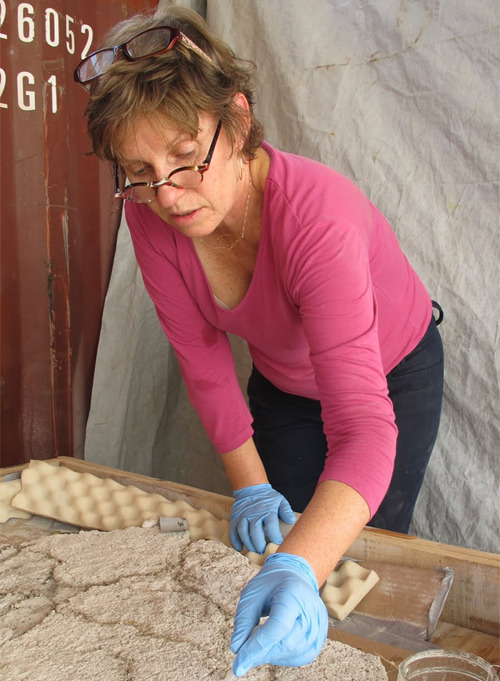Creative Careers: Interview with Conservator Rosa Lowinger
“Conservation is a beautiful metaphor for many things: it is an effort to delay the inevitable, which is the decay of things. It is a poignant endeavor, this desire to keep things from getting lost.”
NYFA recently had the opportunity to interview Rosa Lowinger, a conservator and Principal and Director of Rosa Lowinger & Associates. With an M.A. in art history and conservation from New York University’s Institute of Fine Art, she is an internationally recognized expert in conservation. Her focus is in modern and contemporary sculpture, architecture and public art, and she frequently publishes writings on preservation, art, and culture.
NYFA: Can you tell us what your job entails? Do you still do a lot of hands-on work with objects or are you more focused on the management side of things now?
Rosa Lowinger (RL): Our firm has grown in recent years to be a 14-person endeavor with two offices, one in Miami and one in Los Angeles. We have four trained conservators besides me on staff, seven technicians and three management/ office personnel. Generally my role these days is project troubleshooting and client development. I do some hands-on treatment, particularly on complex works of contemporary art. But generally speaking, I don’t get up on the high scaffold much anymore.
NYFA: What made you want to be a conservator?
RL: I was a studio art and art history major in college. I loved to make things but I didn’t feel that I had a lot to say, which is important for being an artist. I was lucky to have a professor whose wife was a famous paper conservator and he suggested I look into the field. He sponsored my getting a summer internship at The Metropolitan Museum of Art, where I worked in the objects conservation department. I was sold on the field right away. I applied to graduate school a year and a half later.
NYFA: What’s your favorite part of the job? Is there a project you’ve ever worked on that holds a special place in your heart?
RL: My favorite part of the job is the problem-solving component. You see a technical question with an artwork or an architectural feature and you have to deconstruct what to do about it. I would say that my favorite projects are the ones that feel impossible – like a Hail Mary pass in football that you then achieve. There are two that I can name in particular: one is the relocation and conservation of Helen Lundeberg’s 1940 monumental mural titled History of Transportation. It was in terrible condition, having been hit by a car, and graffitied. It was made up of an unusual material called Petrachrome, which is a pictorial terrazzo and it was hard to reproduce. But we did it. There’s a lot of information about it online. It is in the collection of the city of Inglewood, California. I led that treatment when I was lead conservator for sculpture conservation studio, the first firm I founded in Los Angeles.
The other project I loved was salvaging the remaining murals from Holy Trinity Cathedral (Cathédrale Sainte Trinité ) in Port-au-Prince Haiti, after the earthquake.
Both of these projects were done in conjunction with large teams of people and co-conservators.
NYFA: What advice do you have for people who are interested in becoming conservators?
RL: Take chemistry and organic chemistry wherever you can. Doesn’t need to be at Harvard. A local community college is fine. Learn about materials. Work as an artist in whatever capacity you like – fiber, sculpture, painting. You have to really love materials to be a good conservator. And you have to be scrupulously honest with yourself about why things are working and why they are not.
NYFA: You have studios in both Los Angeles and Miami. What are the challenges you face running businesses in different locations?
RL: I rather enjoy the two-city practice. I love both cities and I am connected to both of them by family history. The biggest challenge of course is getting the entire team to consider themselves one firm. We have a lot of talent in our practice and people know different things that can help each other. Getting people to communicate well is one of the challenges, especially because our Miami practice has many people whose native language is Spanish. We pride ourselves actually on being the most diverse firm in the country.
NYFA: Your practice concentrates on the conservation of traditional materials, but it also focuses on the care, documentation, and conservation of artworks created with new technologies, such as video, computer graphics, animation, the Internet, robotics, light, sound, and other kinetic and telecommunication forms. That sounds difficult! How do you tackle projects like this?
RL: The types of works you mention here are perhaps the most challenging in conservation at the moment, mainly because we are having to invent the ways to think about them. They present challenges also because conservators don’t generally possess the hands-on experience of how to deal with them and we need to rely on other experts like computer programmers, video technicians, and electricians. The challenge is mainly to understand what you were looking at and to document scrupulously. There are now certain programs around the world that train conservators who specialize in these materials. What we often do is rely upon them for expertise and refer work to them, or bring them in to work with us.
NYFA: In addition to your conservation work, you’ve also written books, plays and literary essays. Where do you get your inspiration for these writings?
RL: My literary inspiration has thus far been mainly related to Cuba and Cuban culture. I am a Cuban-born American and I travel back-and-forth to Cuba frequently. The conservation of Cuba’s immense built heritage is a priority for me. But in the meantime I’ve become something of an expert in the nightlife of the 1950s, because of my association with Ofelia Fox, whose husband owned Tropicana. I have started working on some things related to conservation. Conservation is a beautiful metaphor for many things: it is an effort to delay the inevitable, which is the decay of things. It is a poignant endeavor, this desire to keep things from getting lost. That’s what the basis of conservation is – keeping things safe that would otherwise disappear. Protecting our very fragile human output. There’s a lot there for me to tackle as a writer, and I’m just about to get to it.
To find conservation and other creative job opportunities, visit NYFA Classifieds’ Jobs in the Arts.
Image Credit: RLA Conservation, Inc.





